Bioactive Co(II), Ni(II), and Cu(II) Complexes Containing a Tridentate Sulfathiazole-Based (ONN) Schiff Base
Abstract
1. Introduction
2. Experimental and Theoretical Premises
2.1. Materials
2.2. Equipments and Characterization Techniques
2.3. Antibacterial Activity Study
2.4. Computational Details
2.5. Synthesis of the Schiff Base (HL)
2.6. Synthesis of the Metal Complexes
- (1)
- CoC32H27S4O7.5N6, yield, %: 80, color: dark green. Found (calcd.) %: C, 47.28 (47.35); H, 3.37 (3.45); N, 10.06 (10.35); Co, 7.19 (7.26). λM = 18 Ω−1 cm−2 mol−1;
- (2)
- NiC32H26S4O7N6, yield, %: 85, color: brown. Found (calcd.) %: C, 47.29 (47.36); H, 3.33 (3.45); N, 10.21 (10.36); Ni, 7.08 (7.25). λM = 15 Ω−1 cm−2 mol−1;
- (3)
- CuC32H33S4O10.5N6, yield, %: 75, color: dark brown. Found (calcd.) %: C, 47.10 (47.08); H, 3.26 (3.43); N, 10.01 (10.29); Cu, 7.59 (7.79). λM = 21 Ω−1 cm−2 mol−1.
3. Results and Discussion
3.1. Spectral Investigations of Metal Complexes
3.1.1. Infrared Spectra
3.1.2. Electronic Spectra and Magnetic Moments
3.2. Thermal Behaviour of the Complexes
3.2.1. Thermal Analysis of (1)
3.2.2. Thermal Analysis of (2)
3.2.3. Thermal Analysis of (3)
3.3. XRD/EDS/SEM Analyses
3.4. Molecular Modelling of the Schiff Base Ligand
3.5. Antibacterial Activity
4. Conclusions
Supplementary Materials
Author Contributions
Funding
Institutional Review Board Statement
Informed Consent Statement
Data Availability Statement
Acknowledgments
Conflicts of Interest
Sample Availability
References
- Finch, R.G.; Greenwood, D.; Whitley, R.J.; Norrby, R.S. Antibiotic and Chemotherapy, 9th ed.; Elsevier Ltd.: Amsterdam, The Netherlands, 2011. [Google Scholar]
- Varshney, A.; Tandon, J.P. Synthesis and spectral studies of tin(IV) complexes with Schiff bases derived from sulpha drugs. J. Chem. Sci. 1986, 97, 141–145. [Google Scholar]
- Maurya, R.C.; Patel, P. Synthesis, magnetic and special studies of some novel metal complexes of Cu(II), Ni(II), Co(II), Zn[II), Nd(III), Th(IV), and UO2(VI) with schiff bases derived from sulfa drugs, viz., sulfanilamide/sulfamerazine and o-vanillin. Spectrosc. Lett. 1999, 32, 213–236. [Google Scholar] [CrossRef]
- Chohan, Z.H.; Shad, H.A.; Nasim, F.H. Synthesis, characterization and biological properties of sulfonamide-derived compounds and their transition metal complexes. Appl. Organometal. Chem. 2009, 23, 319–328. [Google Scholar] [CrossRef]
- Maurya, R.C.; Chourasia, J.; Rajak, D.; Malik, B.A.; Mir, J.M.; Jain, N.; Batalia, S. Oxovanadium(IV) complexes of bioinorganic and medicinal relevance: Synthesis, characterization and 3D molecular modeling of some oxovanadium(IV) complexes involving O, N-donor environment of salicylaldehyde-based sulfa drug Schiff bases. Arab. J. Chem. 2016, 19, 1084–1100. [Google Scholar] [CrossRef]
- Öztürk, Ö.F. Synthesis, spectral, SEM, antibacterial and antifungal activity studies on some Co(II), Ni(II) and Cu(II) complexes of new Schiff base, 4-{(E)-[(2-hydroxynaphthalen-1-yl)methylidene]amino}N-(5-methyl-1,3,4-thiadiazol-2yl)benzenesulfonamide. J. Chem. Soc. Pak. 2018, 40, 191–200. [Google Scholar]
- Gomathi, V.; Selvameena, R. Synthesis, characterization and biological activity of Schiff base complexes of sulfa drug with transition metal. Asian J. Chem. 2013, 25, 2083–2086. [Google Scholar] [CrossRef]
- Chohan, Z.H.; Shad, H.A.; Supuran, C.T. Synthesis, characterization and biological studies of sulfonamide Schiff’s bases and some of their metal derivatives. J. Enzym. Inhib. Med. Chem. 2012, 27, 58–68. [Google Scholar] [CrossRef]
- Pervaiz, M.; Riaz, A.; Munir, A.; Saeed, Z.; Hussain, S.; Rashid, A.; Younas, U.; Adnan, A. Synthesis and characterization of sulfonamide metal complexes as antimicrobial agents. J. Mol. Struct. 2020, 1202, 127284. [Google Scholar] [CrossRef]
- Barnabas, M.J.; Parambadath, S.; Nagappan, S.; Ha, C.S. Sulfamerazine Schiff-base complex intercalated layered double hydroxide: Synthesis, characterization, and antimicrobial activity. Heliyon 2019, 5, e01521. [Google Scholar] [CrossRef]
- Mumtaz, A.; Mahmud, T.; Elsegood, M.R.J.; Weaver, G.W.; Qazi, J.I.; Deeba, F. Synthesis, characterization and in vitro biological studies of novel Schiff base and its transition metal complexes derived from sulphadoxine. Farmacia 2019, 67, 107–110. [Google Scholar] [CrossRef]
- Alyar, S.; Șen, C.; Alyar, H.; Adem, Ș.; Kalkanci, A.; Ozdemir, U.O. Synthesis, characterization, antimicrobial activity, carbonic anhydrase enzyme inhibitor effects, and computational studies on new Schiff bases of Sulfa drugs and their Pd(II), Cu(II) complexes. J. Mol. Struct. 2018, 1171, 214–222. [Google Scholar] [CrossRef]
- Saad, F.A. Nano-synthesis and spectral, thermal, modeling, quantitative structure–activity relationship and docking studies of novel bioactive homo-binuclear metal complexes derived from thiazole drug for therapeutic applications. Appl. Organometal. Chem. 2018, 32, e4352. [Google Scholar] [CrossRef]
- Anacona, J.R.; Rodriguez, J.L.; Camus, J. Synthesis, characterization and antibacterial activity of a Schiff base derived from cephalexin and sulphathiazole and its transition metal complexes. Spectrochim. Acta Part A 2014, 129, 96–102. [Google Scholar] [CrossRef]
- Reiss, A.; Chifiriuc, M.C.; Amzoiu, E.; Cioateră, N.; Dăbuleanu, I.; Rotaru, P. New metal(II) complexes with ceftazidime Schiff base. J. Therm. Anal. Calorim. 2018, 131, 2073–2085. [Google Scholar] [CrossRef]
- Reiss, A.; Cioateră, N.; Chifiriuc, M.C.; Munteanu, G.; Gănescu, A.; Dăbuleanu, I.; Avram, G.; Spînu, C.I.; Rotaru, P. New biologically active mixed-ligand Co(II) and Ni(II) complexes of enrofloxacin. Synthesis, spectral and thermal behavior. J. Therm. Anal. Calorim. 2018, 134, 527–541. [Google Scholar] [CrossRef]
- Reiss, A.; Samide, A.; Ciobanu, G.; Dăbuleanu, I. Synthesis, spectral characterization and thermal behaviour of new metal (II) complexes with Schiff base derived from amoxicillin. J. Chil. Chem. Soc. 2015, 60, 3074–3079. [Google Scholar] [CrossRef]
- Reiss, A.; Chifiriuc, M.C.; Amzoiu, E.; Spînu, C.I. Transition metal(II) complexes with cefotaxime-derived Schiff base: Synthesis, characterization and antimicrobial studies. Bioinorg. Chem. Appl. 2014, 926287. [Google Scholar] [CrossRef]
- Salehi, M.; Kubicki, M.; Galini, M.; Jafari, M.; Malekshah, R.E. Synthesis, characterization and crystal structures of two novel sulfa drug Schiff base ligands derived sulphonamide and molecular docking study. J. Mol. Struct. 2019, 1180, 595–602. [Google Scholar] [CrossRef]
- Rostas, A.M.; Badea, M.; Ruta, L.L.; Farcasanu, I.C.; Maxim, C.; Chifiriuc, M.C.; Popa, M.; Luca, M.; Celan Korosin, N.; Cerc Korosec, R.; et al. Copper(II) Complexes with Mixed Heterocycle Ligands as Promising Antibacterial and Antitumor Species. Molecules 2020, 25, 3777. [Google Scholar] [CrossRef]
- Krajnikova, A.; Rotaru, A.; Gyoryova, K.; Homzova, K.; Manolea, H.O.; Kovarova, J.; Hudecova, D. Thermal behaviour and antimicrobial assay of some new zinc(II) 2-aminobenzoate complex compounds with bioactive ligands. J. Therm. Anal. Calorim. 2015, 120, 73–83. [Google Scholar] [CrossRef]
- Olar, R.; Vasile Scaeteanu, G.; Danila, G.M.; Daniliuc, C.G.; Cerc Korosec, R.; Celan Korosin, N.; Badea, M. Synthesis and characterization of cobalt acrylate–melamine co-crystals. J. Therm. Anal. Calorim. 2019, 135, 2257–2264. [Google Scholar] [CrossRef]
- Lozovan, V.; Kravtsov, V.C.; Gorincioi, E.; Rotaru, A.; Coropceanu, E.B.; Siminel, N.; Fonari, M. Chromism, positional, conformational and structural isomerism in a series of Zn (II) and Cd (II) coordination polymers based on methylated azine N, N’-donor linkers. Polyhedron 2020, 180, 114411. [Google Scholar] [CrossRef]
- Rotaru, A. Thermal and kinetic study of hexagonal boric acid versus triclinic boric acid in air flow. J. Therm. Anal. Calorim. 2017, 127, 755–763. [Google Scholar] [CrossRef]
- Rotaru, A.; Constantinescu, C.; Rotaru, P.; Moanta, A.; Dumitru, M.; Socaciu, M.; Dinescu, M.; Segal, E. Thermal analysis and thin films deposition by matrix assisted pulsed laser evaporation of a 4CN type azomonoether. J. Therm. Anal. Calorim. 2008, 92, 279–284. [Google Scholar] [CrossRef]
- Rotaru, A.; Brătulescu, G.; Rotaru, P. Thermal analysis of azoic dyes: Part I. Non-isothermal decomposition kinetics of [4-(4-chlorobenzyloxy)-3-methylphenyl](p-tolyl)diazene in dynamic air atmosphere. Thermochim. Acta 2009, 489, 63–69. [Google Scholar] [CrossRef]
- Rotaru, A. Thermal analysis and kinetic study of Petrosani bituminous coal from Romania in comparison with a sample of Ural bituminous coal. J. Therm. Anal. Calorim. 2012, 110, 1283–1291. [Google Scholar] [CrossRef]
- Baldan Junior, H.; Silva, E.; Saltarelli, M.; Crispim, D.; Nassar, E.J.; Trujillano, R.; Rives, V.; Vicente, M.A.; Gil, A.; Korili, S.A.; et al. Inorganic–organic hybrids based on sepiolite as efficient adsorbents of caffeine and glyphosate pollutants. Appl. Surf. Sci. Adv. 2020, 1, 100025. [Google Scholar] [CrossRef]
- Roisinel, T.; Rodriguez-Carvajal, J. A windows tool for powder diffraction patterns analysis. In Proceedings of the Seventh European Powder Diffraction Conference (EPDIC 7), Barcelona, Spain, 20–23 May 2000; p. 118. [Google Scholar]
- Abdel-Rahman, L.H.; El-Khatib, R.M.; Nassr, L.A.E.; Abu-Dief, A.M.; Ismael, M.; Seleem, A.A. Metal based pharmacologically active agents: Synthesis, structural characterization, molecular modeling, CT-DNA binding studies and in vitro antimicrobial screening of iron(II) bromosalicylidene amino acid chelates. Spectrochim. Acta A 2014, 117, 366–378. [Google Scholar] [CrossRef]
- Kohn, W.; Becke, A.D.; Parr, R.G. Density Functional Theory of Electronic Structure. J. Phys. Chem. 1996, 100, 12974–12980. [Google Scholar] [CrossRef]
- Tsipis, A.C. DFT flavor of coordination chemistry. Coord. Chem. Rev. 2014, 272, 1–29. [Google Scholar] [CrossRef]
- Simmons, W.W. The Sadtler Handbook of Proton NMR Spectra; Sadtler Research Laboratories, Inc: Philadelphia, PA, USA, 1978. [Google Scholar]
- Geary, W.J. The use of conductivity measurements in organicsolvents for the characterisation of coordination compounds. Coord. Chem. Rev. 1971, 7, 81–122. [Google Scholar] [CrossRef]
- Nakamoto, K. Infrared and Raman Spectra of Inorganic and Coordination Compounds, 4th ed.; Wiley: New York, NY, USA, 1986. [Google Scholar]
- Socrates, G. Infrared Characteristic Group Frequencies; Wiley: London, UK, 1980. [Google Scholar]
- Baxter, J.N.; Cymerman-Craig, J.; Willis, J.B. The infrared spectra of some sulphonamides. J. Chem. Soc. 1955, 669–679. [Google Scholar] [CrossRef]
- Goldstein, M.; Russell, M.A.; Willis, H.A. The infrared spectra of N-substituted sulphonamides. Spectrochim. Acta A 1969, 25, 1275–1285. [Google Scholar] [CrossRef]
- El-Tabl, S.A.; Shakdofa, M.E.M.; Shakdofa, M.E.A. Metal complexes of N’-[2-hydroxy-5-(phenyldiazenyl)-benzylidene]isonicotinohydrazide. Synthesis, spectroscopic characterization and antimicrobial activity. J. Serb. Chem. Soc. 2013, 78, 39–55. [Google Scholar] [CrossRef]
- Nakamoto, K. Infrared and Raman Spectra of Inorganic and Coordination Compounds Part B, 6th ed.; Wiley: Hoboken, NJ, USA, 2009. [Google Scholar]
- Lever, A.B.P. Inorganic Spectroscopy, 2nd ed.; Elsevier: Amsterdam, The Netherlands, 1984. [Google Scholar]
- Figgis, B.N. Introduction to Ligand Fields; Wiley: New York, NY, USA, 1976. [Google Scholar]
- Cotton, F.A.; Williknson, G.; Murillo, C.A.; Bochman, M. Advanced Inorganic Chemistry, 6th ed.; Wiley: New York, NY, USA, 2003. [Google Scholar]
- Estes, W.E.; Gavel, D.P.; Hatfield, W.E.; Hodgson, D.J. Magnetic and structural characterization of dibromo- and dichlorobis(thiazole)copper(II). Inorg. Chem. 1978, 17, 1415–1421. [Google Scholar] [CrossRef]
- Biader Ceipidor, U.; Tomassetti, M.; Bonati, F.; Curini, R.; D’Ascenzo, G. Thermal analysis of Cobalt(II), Nickel(II), Copper(II) and Zinc(II) bis(3,5-dimethyl-1-pyrazolyl)dihydroborates. Thermochim. Acta 1983, 63, 59–66. [Google Scholar] [CrossRef]
- Garcia, J.; Molla, M.C.; Borras, J.; Escriva, E. Thermal study of mepirizol complexes with Co(II), Ni(II), Cu(II) and Zn(II). Thermochim. Acta 1986, 166, 155–162. [Google Scholar] [CrossRef]
- Yu, Y.Y.; Xian, H.D.; Liu, J.F.; Zhao, G.L. Synthesis, characterization, crystal structure and antibacterial activities of transition metal (II) complexes of the Schiff base 2-[(4-methylphenylimino)methyl]-6-methoxyphenol. Molecules 2009, 14, 1747–1754. [Google Scholar] [CrossRef] [PubMed]
- Parr, R.G.; Donnelly, R.A.; Levy, M.; Palke, W.E. Electronegativity: The density functional viewpoint. J. Chem. Phys. 1978, 68, 3801–3807. [Google Scholar] [CrossRef]
- Iczkowski, R.P.; Margrave, J.L. Electronegativity. J. Am. Chem. Soc. 1961, 83, 3547–3551. [Google Scholar] [CrossRef]
- Parr, R.G.; Pearson, R.G. Absolute hardness: Companion parameter to absolute electronegativity. J. Am. Chem. Soc. 1983, 105, 7512–7516. [Google Scholar] [CrossRef]
- Janak, J. Proof that ∂E/∂ni=ε in Density Functional Theory. Phys. Rev. 1978, B18, 7165–7168. [Google Scholar] [CrossRef]
- Parr, R.G.; Szentpaly, L.V.; Liu, S. Electrophilicity index. J. Am. Chem. Soc. 1999, 121, 1922–1924. [Google Scholar] [CrossRef]
- Kleinzeller, A. Ernest Overton’ contribution to the cell membrane concept: A centennial appreciation. Physiology 1997, 12, 49–53. [Google Scholar] [CrossRef]
- Tweedy, B.G. Plant extracts with metal ions as potential antimicrobial agent. Phytopathology 1964, 55, 910–914. [Google Scholar]
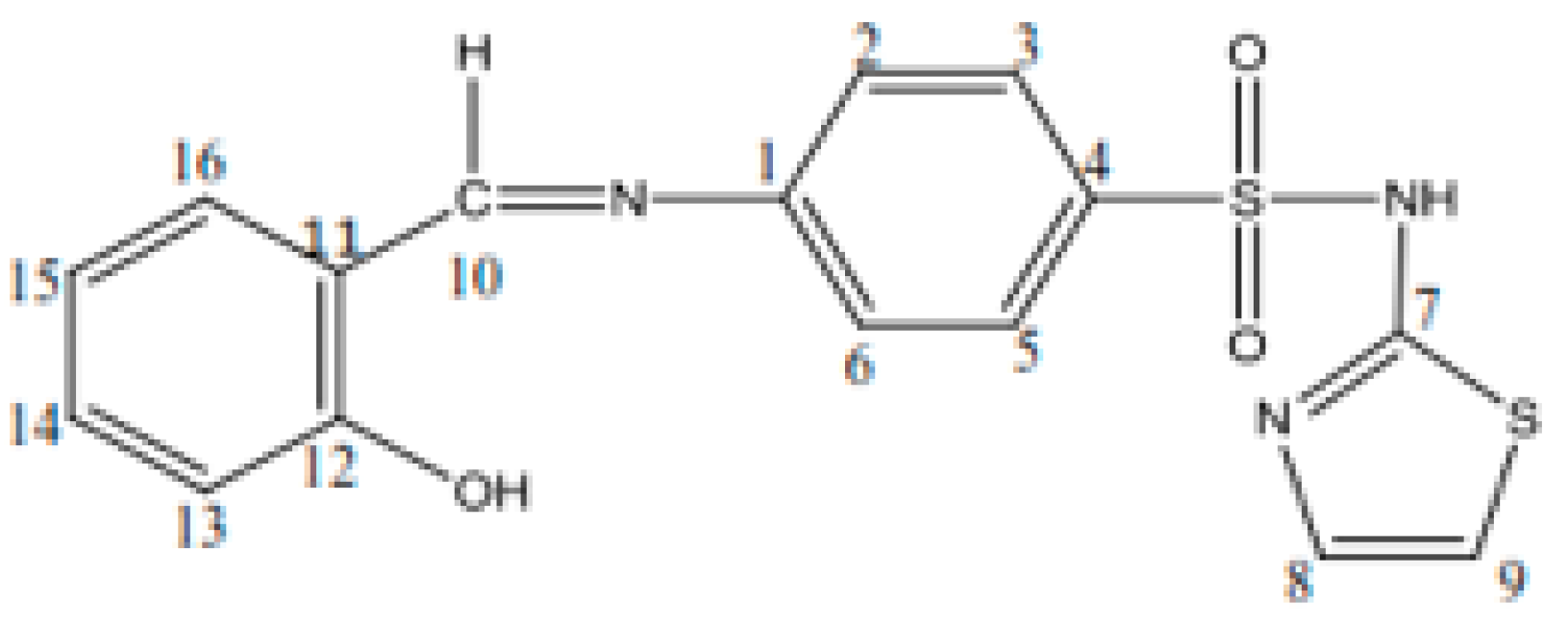


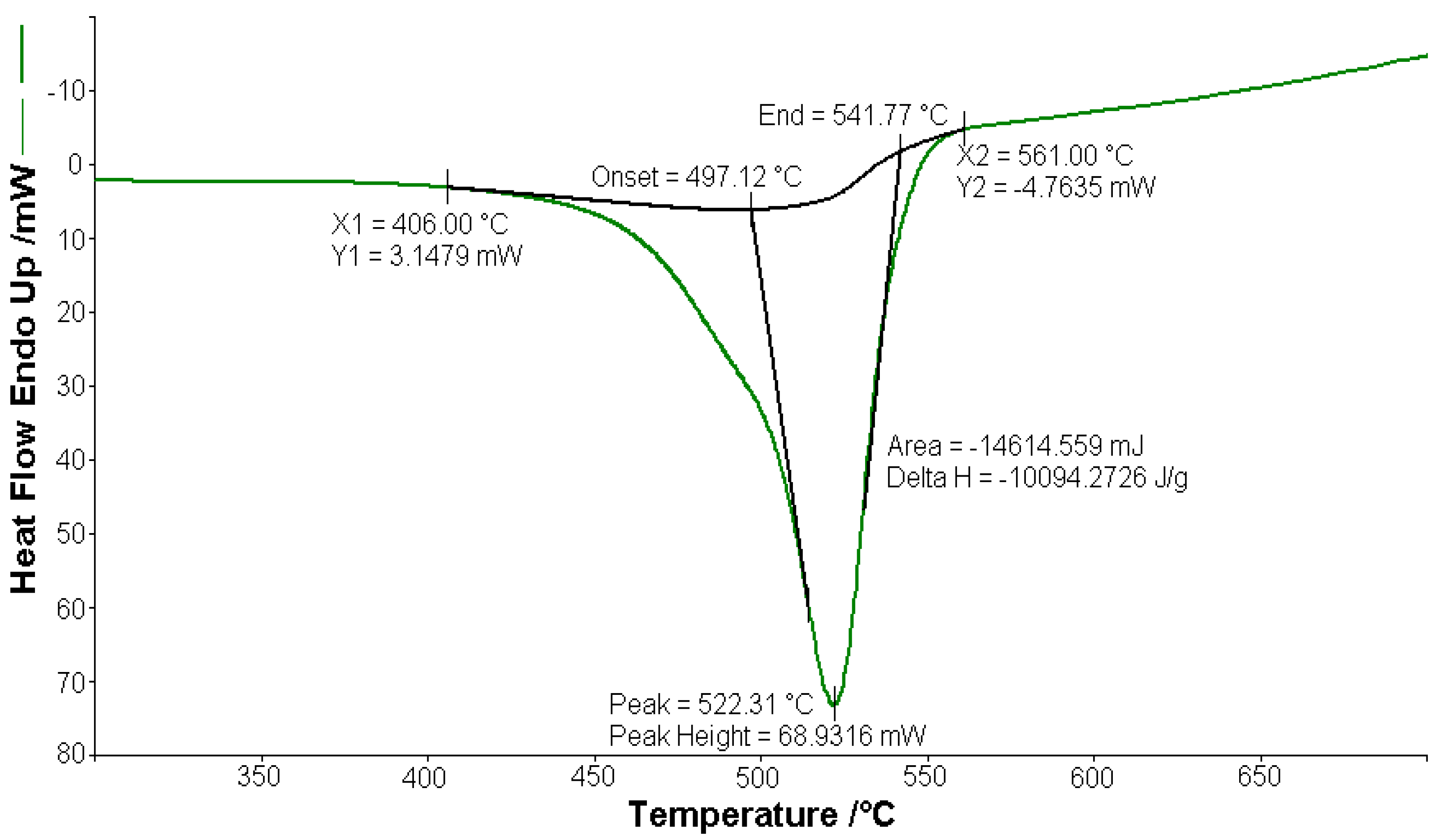
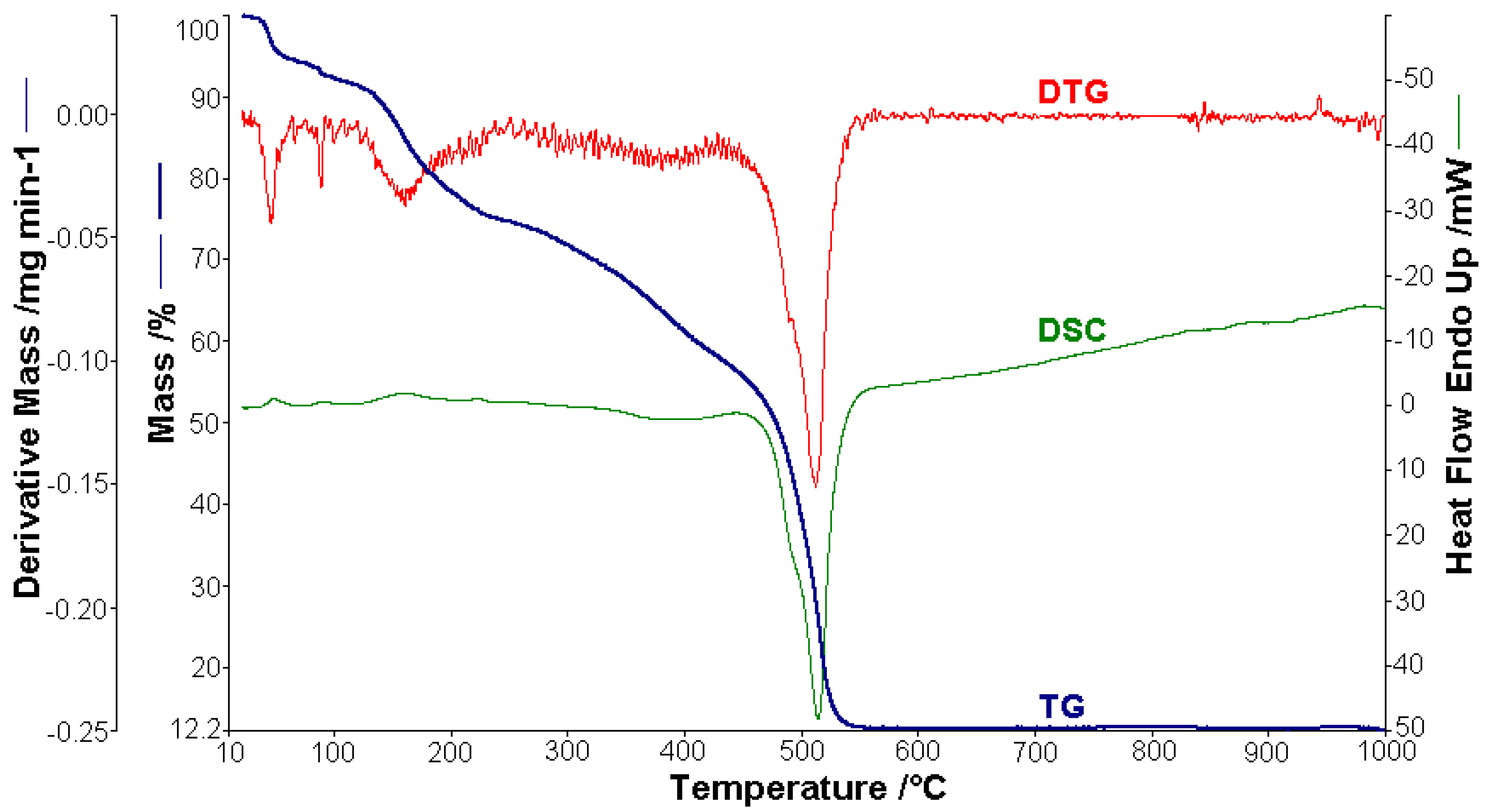
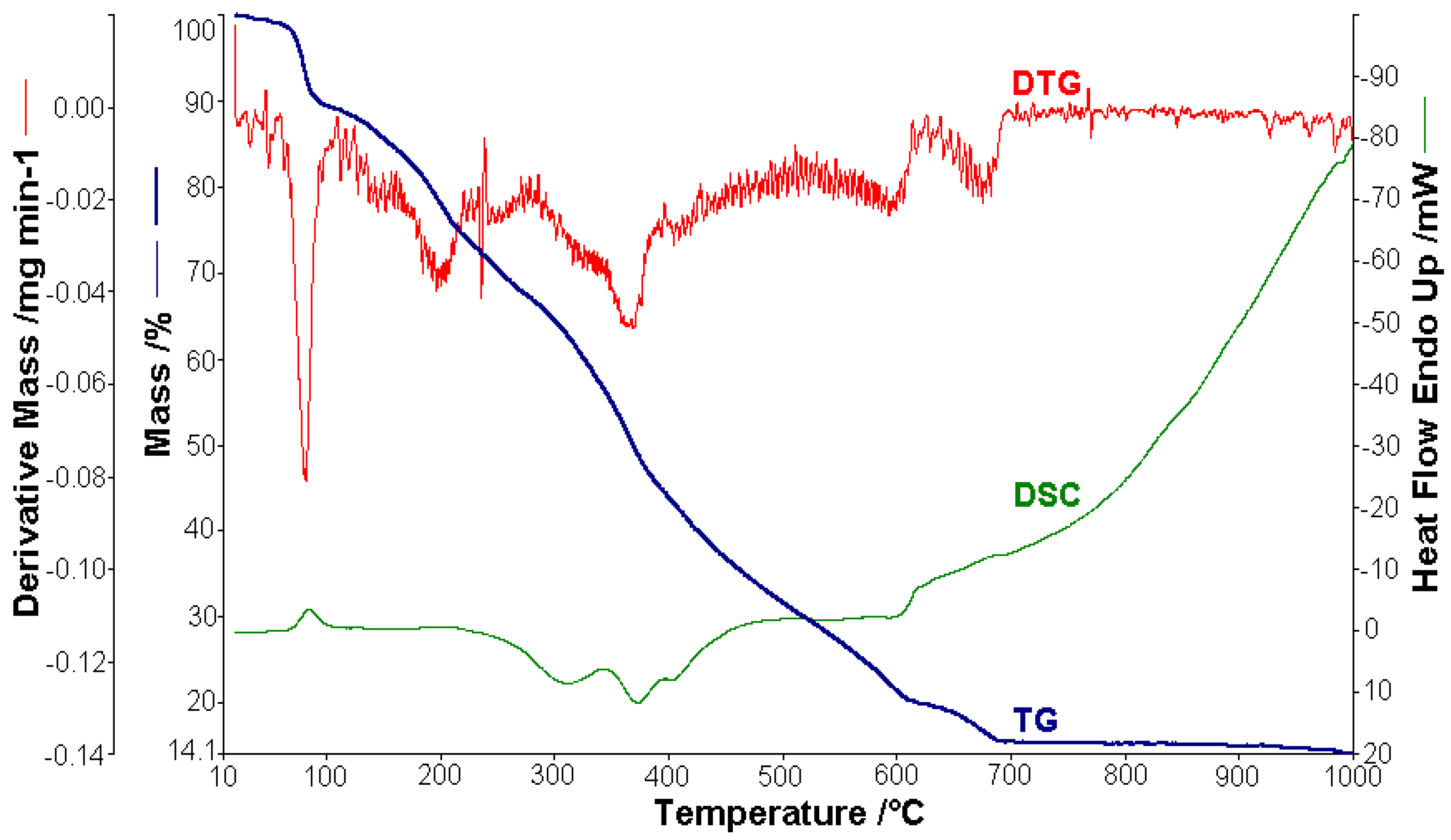
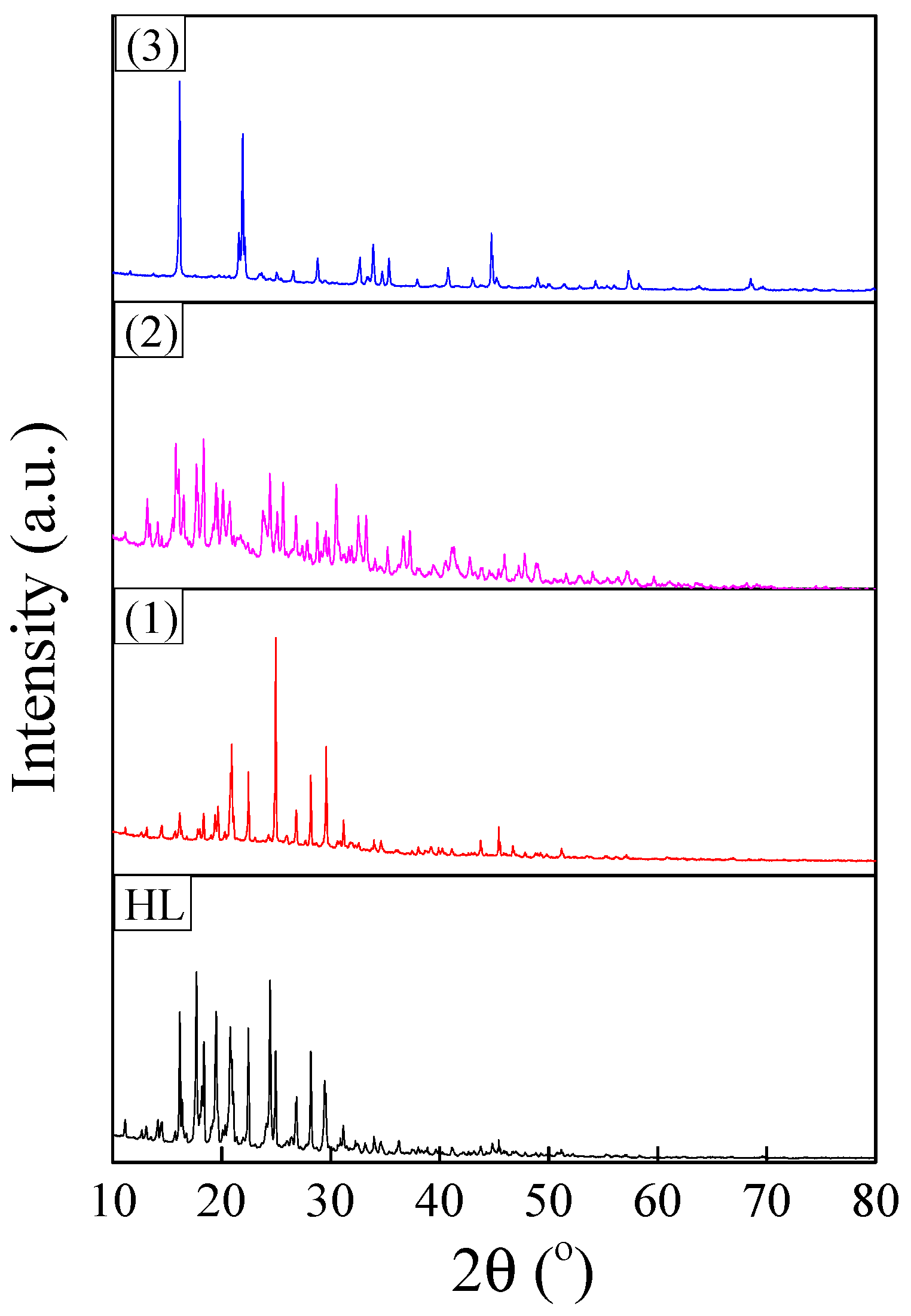
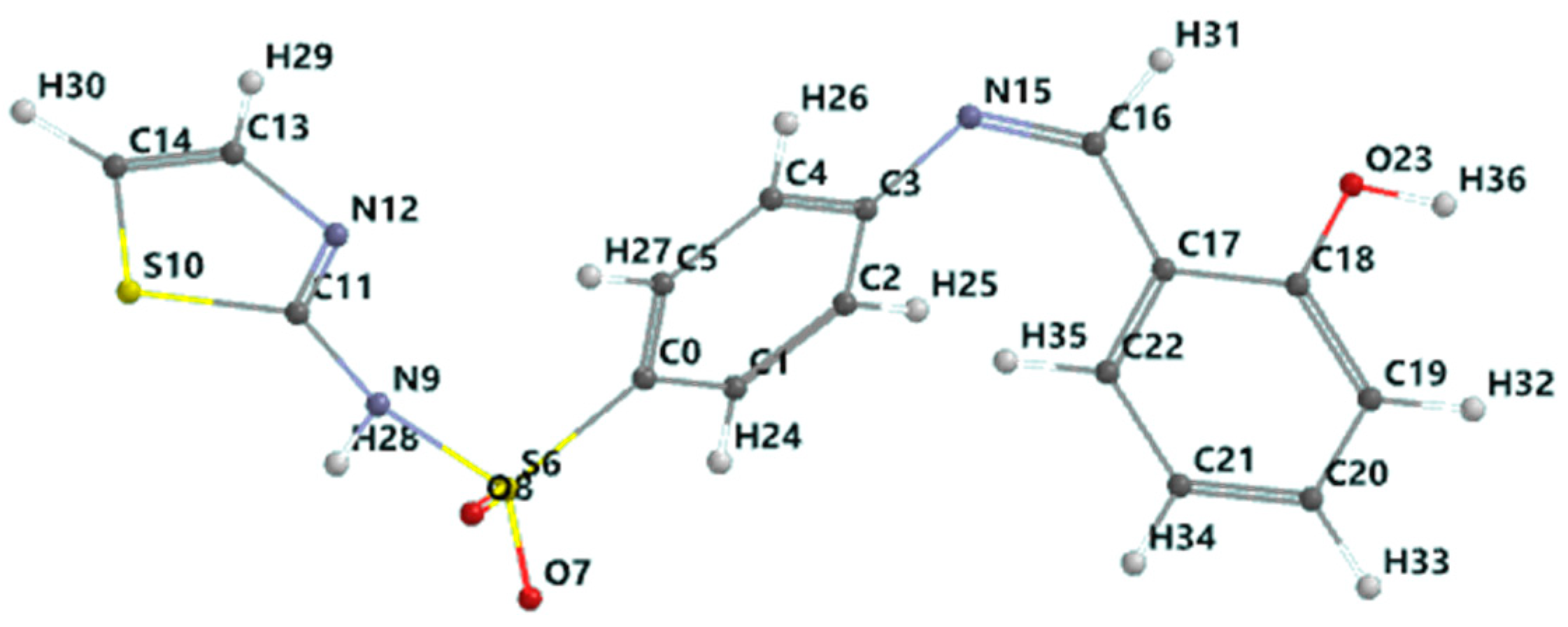
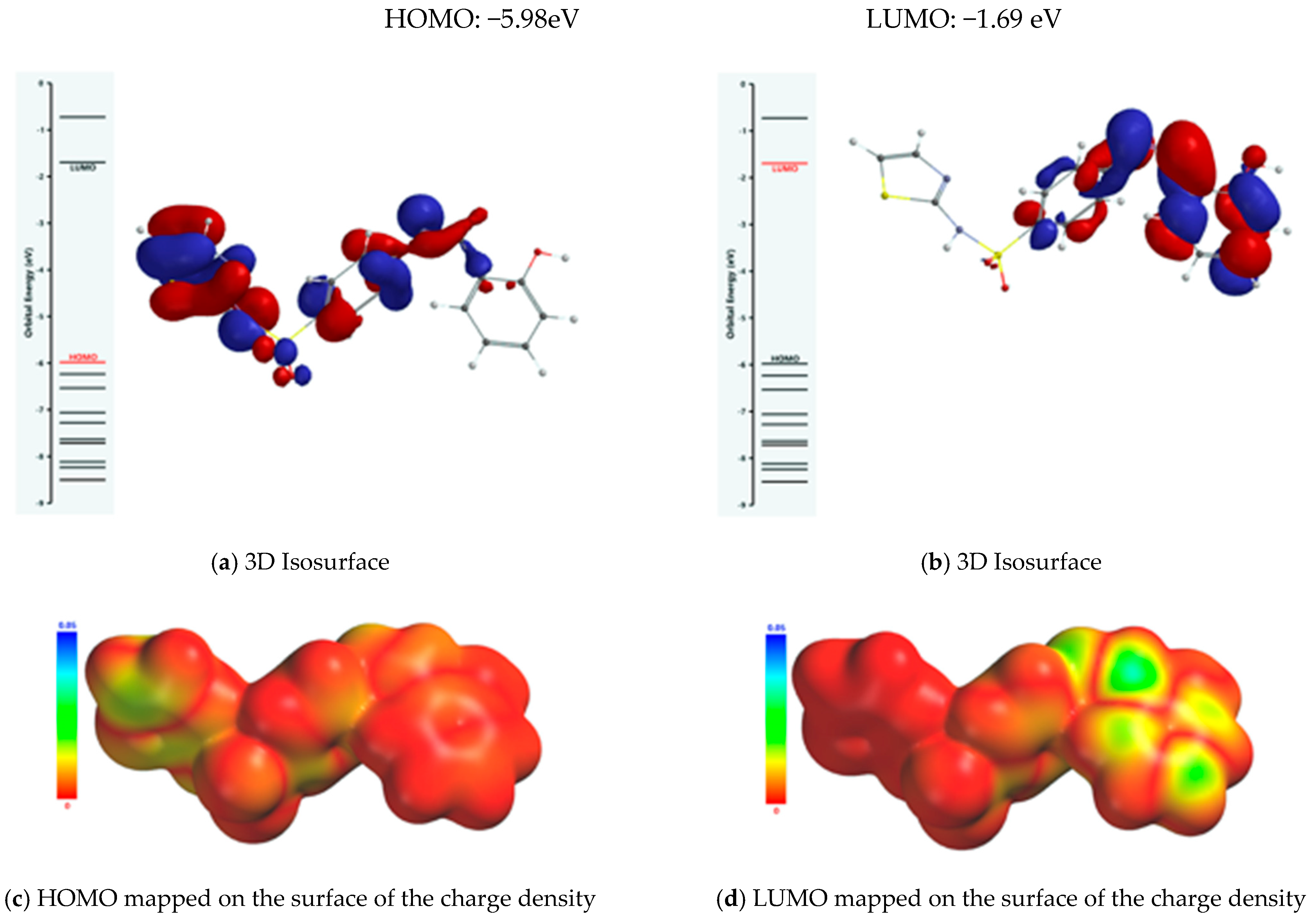


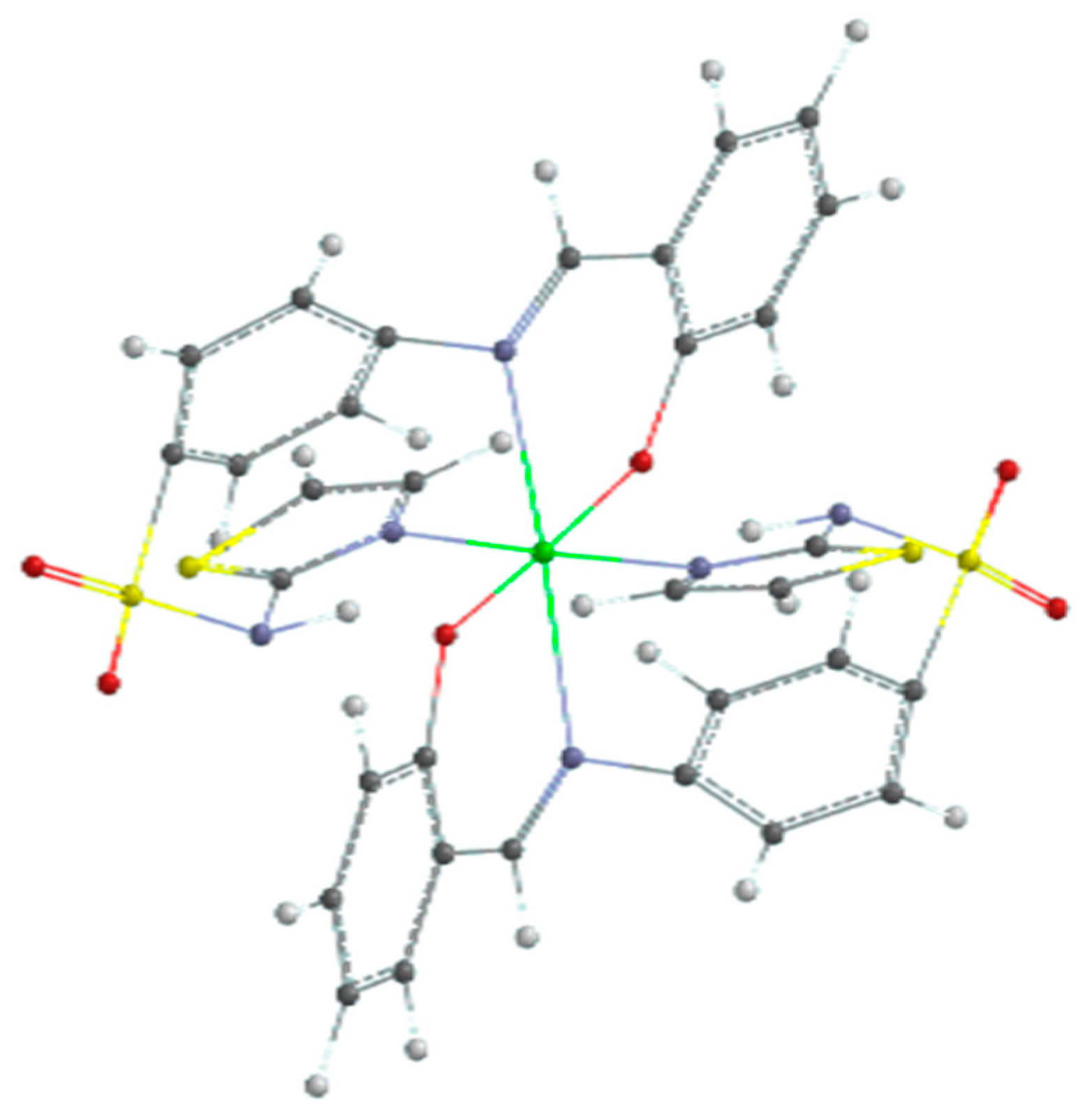
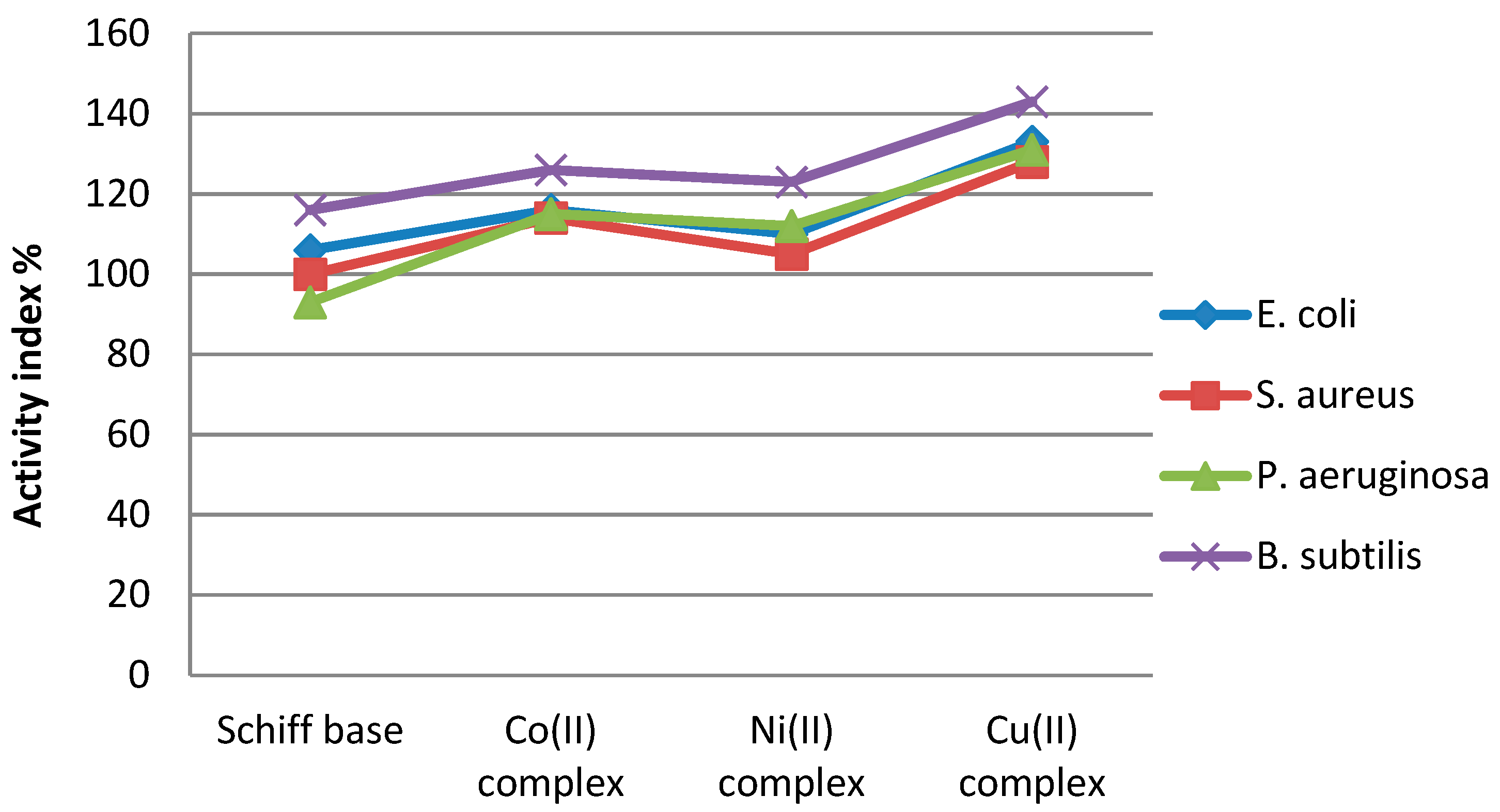
| Stz | HL | (1) | (2) | (3) | Assignments |
|---|---|---|---|---|---|
| - | - | 3445 | 3445 | 3445 | νH2O |
| - | 3375 | - | - | - | ν(OH) phenolic |
| 3354 | - | - | - | - | ν(NH2) asym |
| 3321 | - | - | - | - | ν(NH2) sym |
| 3282 | 3282 | 3282 | 3282 | 3282 | ν(SO2 –NH) |
| - | 1617 | 1577 | 1569 | 1569 | ν(C=N) azm |
| 1540 | 1540 | 1485 | 1480 | 1485 | ν(C=N) thiazole ring |
| 1345 | 1345 | 1345 | 1345 | 1345 | ν(SO2) asym |
| - | 1274 | 1295 | 1305 | 1310 | ν(C-O) phenolic |
| 1110 | 1110 | 1110 | 1110 | 1110 | ν(SO2) sym |
| 635 | 635 | 635 | 635 | 635 | ν(C-S) thiazole ring |
| - | - | 560 | 570 | 565 | ν(M-N) |
| - | - | 450 | 450 | 455 | ν(M-O) |
| Stage | Metal Complex | Temp. Range/°C | DSC Parameters | ∆mexp/% | ∆mcalc/% | Assignment |
|---|---|---|---|---|---|---|
| ∆H/Jg−1; Tmax/°C | ||||||
| [CoL2]·1.5H2O | ||||||
| 1 | CoC32 H27S4O7.5N6 | 23–205 | Weakly endothermic | 3.49 | 3.36 | Loss of lattice water molecule |
| ↓-1.5H2O | ||||||
| 2 | CoC32 H24S4O6N6 | 205–242 | 57.79; 226.4 | 2.68 | 2.14 | Loss of ammonia molecule |
| ↓-NH3 | ||||||
| 3 | CoC32 H21S4O6N5 | 242–1000 | −10094.2; 522.31 | 92.56 | 92.65 | Loss of organic moieties and a part of Co(II) |
| ↓-organic moieties1/4Co | 1.14 | 1.75 | residue (1/4CoO) | |||
| [NiL2 ]·H2O | ||||||
| 1 | NiC32 H26 S4O7N6 | 22–62 | 75.93; 47.9 | 5.36 | - | Water humidity |
| ↓-humidity | ||||||
| 2 | NiC32 H26S4O7N6 | 62–102 | 40.92; 90.2 | 2.52 | 2.12 | Loss of lattice water molecule |
| ↓-H2O | ||||||
| 3 | NiC32H24 S4O6N6 | 106–560 | −6420.7; 514.4 | 75.22 | 75.81 | Loss of organic moieties |
| ↓-organic moieties NiO and 4C | 16.89 | 16.64 | Residue (NiO and 4C) | |||
| [CuL2 ]·4.5H2O | ||||||
| 1 | CuC32 H33 S4O10.5N6 | 20–60 | Weakly endothermic | 1.09 | - | Water humidity |
| ↓-humidity | ||||||
| 2 | CuC32 H33S4O10.5N6 | 60–110 | 176.37; 84.4 | 9.89 | 9.41 | Loss of lattice water molecules |
| ↓-4.5H2O | ||||||
| 3 | CuC32 H24 S4O6N6 | 110–700 | −428.25; 371.2 | 74.40 | 74.78 | Loss of organic moieties |
| ↓-organic moietiesCuO and 4C | −7.11; 403.1 | 14.12 | 14.86 | Residue (CuO and 4C) | ||
| Parameter | (HL) | (1) | (2) | (3) |
|---|---|---|---|---|
| a/Å | 9.22 (1) | 9.29 (1) | 9.29 (9) | 9.34 (9) |
| b/Å | 11.34 (1) | 11.39 (6) | 11.44 (1) | 11.45 (3) |
| c/Å | 28.41 (7) | 28.64 (5) | 28.46 (2) | 28.56 (3) |
| α/° | 90.00 | 90.00 | 90.00 | 90.00 |
| β/° | 91.8 (3) | 92.1 (4) | 92.4 (1) | 92.0 (3) |
| γ/° | 90.00 | 90.00 | 90.00 | 90.00 |
| V/Å3 | 2970.0 (8) | 3030.8 (4) | 3025.5 (9) | 3056.6 (7) |
| Compound | N, % at | S, % at | Co, % at | Cu, % at | Ni, % at | N:S | N:M(II) |
|---|---|---|---|---|---|---|---|
| HL | 11.0 | 7.2 | - | - | - | 1.52 | - |
| (1) | 9.2 | 6.0 | 1.5 | - | - | 1.53 | 6.1 |
| (2) | 3.5 | 2.4 | - | - | 0.7 | 1.45 | 5.0 |
| (3) | 6.1 | 4.0 | - | 1.1 | - | 1.52 | 5.5 |
| Compound | EHOMO /eV | ELUMO /eV | ΔE /eV | χ /eV | μ /eV | η /eV | S /eV−1 | ω /eV |
|---|---|---|---|---|---|---|---|---|
| HL | −5.98 | −1.69 | 4.29 | 3.84 | −3.84 | 2.14 | 0.23 | 3.43 |
| Cu(II) complex | −5.90 | −2.65 | 3.25 | 4.28 | −4.28 | 1.62 | 0.31 | 5.62 |
| Compound | E. coli | S. aureus | P. aeruginosa | B. subtilis |
|---|---|---|---|---|
| HL | 32 | 35 | 30 | 35 |
| (1) | 35 | 40 | 37 | 38 |
| (2) | 33 | 37 | 36 | 37 |
| (3) | 40 | 45 | 42 | 43 |
| Amoxicillin | 30 | 35 | 32 | 30 |
| DMSO | - | - | - | - |
Publisher’s Note: MDPI stays neutral with regard to jurisdictional claims in published maps and institutional affiliations. |
© 2021 by the authors. Licensee MDPI, Basel, Switzerland. This article is an open access article distributed under the terms and conditions of the Creative Commons Attribution (CC BY) license (https://creativecommons.org/licenses/by/4.0/).
Share and Cite
Reiss, A.; Cioateră, N.; Dobrițescu, A.; Rotaru, M.; Carabet, A.C.; Parisi, F.; Gănescu, A.; Dăbuleanu, I.; Spînu, C.I.; Rotaru, P. Bioactive Co(II), Ni(II), and Cu(II) Complexes Containing a Tridentate Sulfathiazole-Based (ONN) Schiff Base. Molecules 2021, 26, 3062. https://doi.org/10.3390/molecules26103062
Reiss A, Cioateră N, Dobrițescu A, Rotaru M, Carabet AC, Parisi F, Gănescu A, Dăbuleanu I, Spînu CI, Rotaru P. Bioactive Co(II), Ni(II), and Cu(II) Complexes Containing a Tridentate Sulfathiazole-Based (ONN) Schiff Base. Molecules. 2021; 26(10):3062. https://doi.org/10.3390/molecules26103062
Chicago/Turabian StyleReiss, Aurora, Nicoleta Cioateră, Aurelian Dobrițescu, Mihaela Rotaru, Alice Carla Carabet, Filippo Parisi, Anca Gănescu, Irina Dăbuleanu, Cezar Ionuț Spînu, and Petre Rotaru. 2021. "Bioactive Co(II), Ni(II), and Cu(II) Complexes Containing a Tridentate Sulfathiazole-Based (ONN) Schiff Base" Molecules 26, no. 10: 3062. https://doi.org/10.3390/molecules26103062
APA StyleReiss, A., Cioateră, N., Dobrițescu, A., Rotaru, M., Carabet, A. C., Parisi, F., Gănescu, A., Dăbuleanu, I., Spînu, C. I., & Rotaru, P. (2021). Bioactive Co(II), Ni(II), and Cu(II) Complexes Containing a Tridentate Sulfathiazole-Based (ONN) Schiff Base. Molecules, 26(10), 3062. https://doi.org/10.3390/molecules26103062







